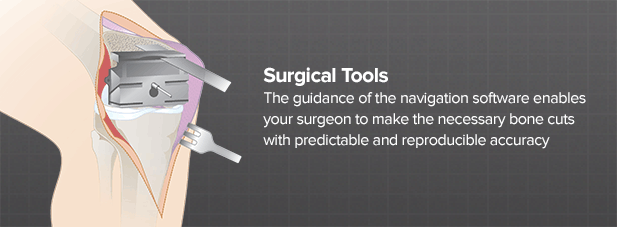
4) Bone preparation
The ends of the thigh bone and of the lower leg need to be prepared and cut so that according to the size and design of the implant, the diseased bone is removed and the artificial joint can properly fit into your knee anatomy.
A cutting block is fixed to the bone to control the cutting tool. The guidance of the navigation software supports surgeons to make the necessary bone cuts with more predictable and reproducible accuracy1 compared to conventional surgery. Once the cut is made, the navigation software enables your surgeon to check the accuracy and make alterations if required. This provides the surgery with instant feedback. Providing the surgeon with this feedback at the time of surgery supports the surgeon in making a correction if required rather than waiting until a post-operative X-Ray.
The damaged or diseased parts of the bones are removed and your surgeon prepares the bone ends according to the chosen implant’s size and design.
5) Final alignment
Through joint replacement, metal and plastic devices replace diseased or damaged bone and cartilage, restoring alignment and function. Once necessary bone cuts have been made, the implant components for the lower leg and the thighbone are placed on the bone ends.
One metal component is attached to the thighbone, while two components are placed on the cut plateau of the lower leg. The metal implant is placed on the removed bone parts, and a polyethylene component in your new artificial joint functions similarly to the cartilage in your natural knee.
Before the final implants are placed in the knee joint, surgeons use trial implants to see if the chosen size and position fit well before proceeding. The navigation software runs a final leg alignment test and allows the surgeon to analyze the stability curve of your artificial knee on the computer screen. This enables surgeons to improve soft tissue balancing intra-operatively if required.
Once the calculated alignment and balance results on the computer screen are achieved, the trial implants will be replaced with the final artificial components and the incision can be closed.
The navigation software enables your surgeon to check and re-check all steps during the procedure to help place your final knee components in their ideal positions.